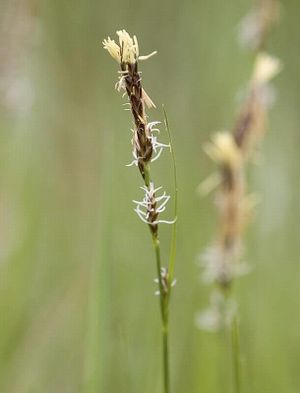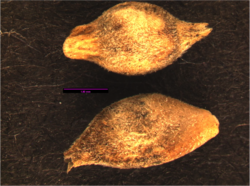Carex inops
- Scientific Name: Carex inops
- Family: Cyperaceae
- Common Names: long-stolon sedge
- Codon: CARINO
Contents
Taxonomy
| Scientific classification | |
|---|---|
| Kingdom: | Plantae |
| Subkingdom: | Viridiplantae |
| Phylum: | Tracheophyta |
| Subphylum: | Spermatophytina |
| Class: | Magnoliopsida |
| Subclass: | Lilianae |
| Order: | Poales |
| Family: | Cyperaceae |
| Genus: | Carex L. |
| Species: | Carex inops L.H. Bailey |
Description
Perennial, rhizomatous, loosely caespitose sedge with erect culms to 50 cm tall.[2] Low to medium height compared to other Carex species.[3] Leaves 1-3 wide, flat, often shorter than the culms.[4] Tufts of dead leaves persist at base.[3] Inflorescences are spikes, with a solitary male spike usually pediceled above the female spikes, which is subtended by a leafy bract.[4] Perigynia is a 3-sided achene enclosed by a bract,[4] from 1.6 to 2.5 mm long.[3]
Bloom Period
April-July[5]
Distribution
Both sides of the Cascades, from British Columbia to California, inland to the Rocky Mountains and Great Plains.[5]
Habitat
Prairies, forest openings, open meadows, along streams.[5]
Uses
Wildlife: Rodents, lagomorphs, and ungulates graze sun sedge. On the Pawnee National Grassland, Ord's kangaroo rats, northern grasshopper mice, thirteen-lined ground squirrels, and deer mice utilization of sun sedge ranged from 0.1% to 5.0% across 1 year. Seasonal utilization was not given. Sun sedge was an important component of the spring and early summer diets of black-tailed jackrabbits on the Pawnee National Grassland. In Wind Cave National Park, elk use of sun sedge was similar from winter to summer (3.7-5.0%) and least in fall (0.9%). Sun sedge was a minor component of the pronghorn diet on the Pawnee National Grassland. Use peaked at 4% in April and May, with only trace amounts consumed in other months. Sun sedge was also a minor component in the pronghorn diet (17% frequency but 1%-4% utilization) in a needle-and-thread grass-western wheatgrass community in southeastern Alberta. On the Pawnee National Grasslands, bison grazed sun sedge in trace amounts in December and did not utilize it in other months.[3]
First Nations: Use by Navajo as a gastrointestinal aid and to help fight infections.[6]
Propagation
Long-stolon sedge is wind pollinated. Little is known of either sun sedge's ability to establish from seed or its growth rate.[3]
Seed
Seed sample from: 2010
Average measurement: 3.6 x1.6 x 1.3
Measurement Range: L: 2.5 – 4.5, W: 1.2 – 2, D: 1 – 1.9
Features
Shape: Seeds narrow at hilum and opposite apex, rounded in middle. Opposite apex usually sharply pointed. Seed sometimes has bits of husk still attached. Hilum circular.
Color: Tan with some darker brown or black spotting. Hilum usually brown.
Surface: Some concave patches, entire seed covered in fine hair, and matte.
Latitudinal Cross Section: elliptical 
Longitudinal Cross Section: elliptical ![]()
Basic Explanations and Assumptions:
The dimensions for the seeds are length x width x depth. The location of the hilum is used as the base of the seed, and the length is measured from hilum to the opposite apex. Where a style is present, the length is measured from the hilum to the bottom of the style. Width is measured at a right angle to the length at the widest part. Depth is measured at a right angle to the intersection of height and width lines.
Measurements included are the mean average for each measurement of ten separate seeds.
All measurements in millimeters unless otherwise noted.
Photo Gallery
References
http://plants.usda.gov/java/profile?symbol=CAIN9 http://biology.burke.washington.edu/herbarium/imagecollection.php http://www.fs.fed.us/database/feis/plants/graminoid/carino/all.html http://mtnhp.org/ecology/Guide_Report.asp?elcode=CEGL001471 http://biology.burke.washington.edu/herbarium/imagecollection/wtu27000-27499/lg/wtu027233_lg.jpg http://linnet.geog.ubc.ca/Atlas/Atlas.aspx?sciname=Carex%20inops
- ↑ Integrated Taxonomic Information System. Retrieved from https://www.itis.gov/servlet/SingleRpt/SingleRpt?search_topic=TSN&search_value=39650
- ↑ Flora of North America. Retrieved from http://dev.floranorthamerica.org/Carex_inops
- ↑ 3.0 3.1 3.2 3.3 3.4 USFS Fire Effects Information System. Retrieved from https://www.fs.fed.us/database/feis/plants/graminoid/carino/all.html
- ↑ 4.0 4.1 4.2 Bowcutt, F., & Hamman, S. (2016). Vascular Plants of the South Sound Prairies. p. 114.
- ↑ 5.0 5.1 5.2 WTU Herbarium, Burke Museum, & University of Washington. Retrieved from https://biology.burke.washington.edu/herbarium/imagecollection/taxon.php?Taxon=Carex%20inops
- ↑ Native American Ethnobotany Database. Retrieved from http://naeb.brit.org/uses/search/?string=carex+inops




